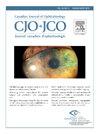Risk factors associated with disease relapse in healing/healed arterial injury and biopsy-proven giant cell arteritis
IF 2.8
4区 医学
Q1 OPHTHALMOLOGY
Canadian journal of ophthalmology. Journal canadien d'ophtalmologie
Pub Date : 2025-10-01
DOI:10.1016/j.jcjo.2025.03.008
引用次数: 0
Abstract
Objective
To compare characteristics of relapses in patients with biopsy-proven giant cell arteritis (GCA) and healing/healed (HH) arterial injury on temporal artery biopsy (TAB).
Design
Single-centre, retrospective cohort study.
Participants
One hundred thirty-five consecutive patients with GCA-positive or HH arterial injury on TAB and minimum 12-month follow-up from January 2009 to December 2018.
Methods
Clinical characteristics and serological markers were evaluated for their potential as risk factors for symptomatic or biochemical relapses.
Results
Relapse rates were 16.9% and 25.7% in the HH and GCA-positive groups, respectively (p = 0.21). Median length of follow-up was 34.8 months in the HH group and 36.6 months in the GCA-positive group. No statistically significant difference between groups with respect to time to relapse, steroid doses at relapse, and presence of symptoms and elevated biomarkers at relapse. In GCA-positive patients, aortitis was associated with relapse (p = 0.050) and with earlier relapse rates (p = 0.007). Aortitis (HR 7.96; p = 0.007) and jaw claudication (HR 5.08; p = 0.019) were found to be independent risk factors for relapse. In HH arterial injury patients, aortitis and aortic aneurysm were associated with earlier relapses (p = 0.044 and p = 0.047, respectively) and were associated with disease relapses on univariable analysis (p = 0.044 and p = 0.047, respectively) but not on multivariable analysis.
Conclusions
The presence of large-vessel vasculitis is associated with disease relapse in both HH and GCA-positive biopsy patients. Similar relapse characteristics between both HH and biopsy-proven patients may suggest that clinicians manage these patients similarly in context of clinical history rather than modify management purely based on pathology findings.
在愈合/已愈合的动脉损伤和活检证实的巨细胞动脉炎中与疾病复发相关的危险因素
目的:比较活检证实的巨细胞动脉炎(GCA)和颞动脉活检(TAB)动脉损伤愈合/痊愈(HH)患者的复发特征:单中心、回顾性队列研究:2009年1月至2018年12月期间,135名连续的颞动脉活检GCA阳性或HH动脉损伤患者,随访至少12个月:评估临床特征和血清学标志物作为症状性或生化复发风险因素的可能性:HH组和GCA阳性组的复发率分别为16.9%和25.7%(P = 0.21)。HH 组和 GCA 阳性组的中位随访时间分别为 34.8 个月和 36.6 个月。在复发时间、复发时的类固醇剂量、复发时的症状和生物标志物升高方面,组间差异无统计学意义。在 GCA 阳性患者中,大动脉炎与复发有关(p = 0.050),与较早的复发率有关(p = 0.007)。研究发现,大动脉炎(HR 7.96;p = 0.007)和下颌跛行(HR 5.08;p = 0.019)是导致复发的独立危险因素。在HH动脉损伤患者中,主动脉炎和主动脉瘤与较早复发有关(分别为p = 0.044和p = 0.047),在单变量分析中与疾病复发有关(分别为p = 0.044和p = 0.047),但在多变量分析中与疾病复发无关:结论:大血管炎的存在与HH和GCA活检阳性患者的疾病复发有关。HH和活检证实的患者具有相似的复发特征,这可能表明临床医生应根据临床病史对这些患者进行类似的管理,而不是纯粹根据病理结果来修改管理方法。
本文章由计算机程序翻译,如有差异,请以英文原文为准。
求助全文
约1分钟内获得全文
求助全文
来源期刊
CiteScore
3.20
自引率
4.80%
发文量
223
审稿时长
38 days
期刊介绍:
Official journal of the Canadian Ophthalmological Society.
The Canadian Journal of Ophthalmology (CJO) is the official journal of the Canadian Ophthalmological Society and is committed to timely publication of original, peer-reviewed ophthalmology and vision science articles.

 求助内容:
求助内容: 应助结果提醒方式:
应助结果提醒方式:


